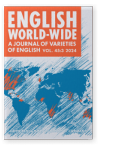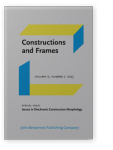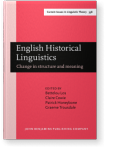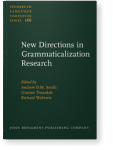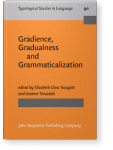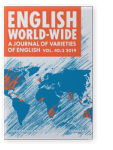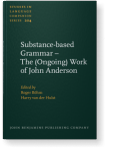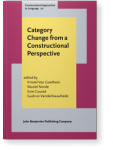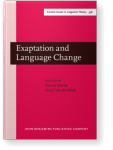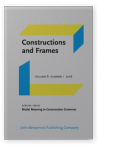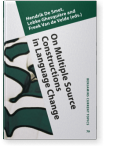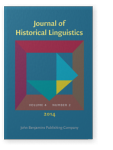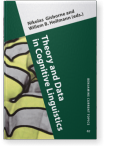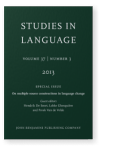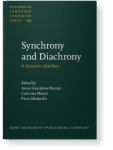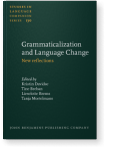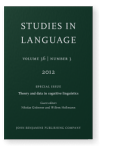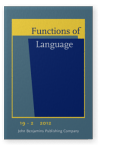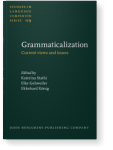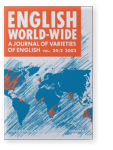Graeme Trousdale
List of John Benjamins publications for which Graeme Trousdale plays a role.
Journal
Issues in Diachronic Construction Morphology
Edited by Muriel Norde and Graeme Trousdale
Special issue of Constructions and Frames 15:2 (2023) v, 152 pp.
Subjects Cognition and language | Functional linguistics | Syntax | Theoretical linguistics
English Historical Linguistics: Change in structure and meaning. Papers from the XXth ICEHL
Edited by Bettelou Los, Claire Cowie, Patrick Honeybone and Graeme Trousdale
[Current Issues in Linguistic Theory, 358] 2022. viii, 349 pp.
Subjects English linguistics | Germanic linguistics | Historical linguistics
New Directions in Grammaticalization Research
Edited by Andrew D.M. Smith, Graeme Trousdale and Richard Waltereit
[Studies in Language Companion Series, 166] 2015. xv, 302 pp.
Subjects Historical linguistics | Morphology | Syntax | Theoretical linguistics
Gradience, Gradualness and Grammaticalization
Edited by Elizabeth Closs Traugott and Graeme Trousdale
[Typological Studies in Language, 90] 2010. ix, 306 pp.
Subjects Historical linguistics | Syntax | Theoretical linguistics
2023 Issues in Diachronic Construction Morphology Issues in Diachronic Construction Morphology, Norde, Muriel and Graeme Trousdale (eds.), pp. 145–159 | Review article
2019 Raymond Hickey, ed. 2015. Researching Northern English English World-Wide 40:3, pp. 345–348 | Review
2018 Figurativeness in English grammar: The role of metonymic tropes and schemes of repetition Substance-based Grammar – The (Ongoing) Work of John Anderson, Böhm, Roger and Harry van der Hulst (eds.), pp. 311–336 | Chapter
This chapter considers the relationship between constructions and certain kinds of figurative language, namely metonymic tropes and schemes of repetition. The role of metonymy in shifts from morphological compounds to derivational affixes is explored, along with creation of affixoids. The chapter… read more
2018 Chapter 11. Change in category membership from the perspective of construction grammar: A commentary Category Change from a Constructional Perspective, Van Goethem, Kristel, Muriel Norde, Evie Coussé and Gudrun Vanderbauwhede (eds.), pp. 291–308 | Chapter
2016 Exaptation from the perspective of construction morphology Exaptation and Language Change, Norde, Muriel and Freek Van de Velde (eds.), pp. 163–195 | Article
In this paper, we explore how the process of exaptation can be modelled within a constructional framework of morphology. Assuming that constructions (of varying levels of schematicity and complexity) are organized in constructional networks, we consider issues related to ‘obsolescence’ and… read more
2016 Response to Wärnsby Modal Meaning in Construction Grammar, Cappelle, Bert and Ilse Depraetere (eds.), pp. 54–65 | Article
2015 Introduction New Directions in Grammaticalization Research, Smith, Andrew D.M., Graeme Trousdale and Richard Waltereit (eds.), pp. 1–8 | Article
2015 Multiple inheritance and constructional change On Multiple Source Constructions in Language Change, De Smet, Hendrik, Lobke Ghesquière and Freek Van de Velde (eds.), pp. 19–42 | Article
Language as a network of dependencies or constructions is a central feature of many cognitive theories of grammar. In this network, inheritance relationships are used to describe synchronic facts about a language whereby members of a less abstract set inherit properties from a more general set, and… read more
2014 Contentful constructionalization Journal of Historical Linguistics 4:2, pp. 256–283 | Article
We present a constructionalization framework for thinking about the development of contentful (“lexical”) constructions over time. This framework incorporates and goes beyond earlier work on lexicalization, which largely focuses on reduction in the form of specific lexical items. A… read more
2014 Theory and data in diachronic Construction Grammar: The case of the what with construction Theory and Data in Cognitive Linguistics, Gisborne, Nikolas and Willem B. Hollmann (eds.), pp. 115–140 | Article
Constructionalization (the diachronic creation of conventional symbolic units at different levels of schematicity and complexity) is a process which involves a series of micro-changes at different linguistic levels. The development of what with constructions in English is argued to be a case of… read more
2013 Multiple inheritance and constructional change On multiple source constructions in language change, De Smet, Hendrik, Lobke Ghesquière and Freek Van de Velde (eds.), pp. 491–514 | Article
Language as a network of dependencies or constructions is a central feature of many cognitive theories of grammar. In this network, inheritance relationships are used to describe synchronic facts about a language whereby members of a less abstract set inherit properties from a more general set, and… read more
2013 Gradualness in language change: A constructional perspective Synchrony and Diachrony: A dynamic interface, Giacalone Ramat, Anna, Caterina Mauri and Piera Molinelli (eds.), pp. 27–42 | Article
This chapter considers the constructional changes which may both precede and follow the establishment of a new construction in a language, building on work that has been carried out in grammaticalization, lexicalization and degrammaticalization. It also considers the relationship between abrupt… read more
2012 Grammaticalization, constructions and the grammaticalization of constructions Grammaticalization and Language Change: New reflections, Davidse, Kristin, Tine Breban, Lieselotte Brems and Tanja Mortelmans (eds.), pp. 167–198 | Article
Research within constructional approaches to language has begun to develop a framework for modelling diachronic variation, but the precise relationship between diachronic construction grammar and grammaticalization has yet to be fully worked out (Noël 2007). The article includes discussion of some… read more
2012 Theory and data in diachronic Construction Grammar: The case of the what with construction Theory and data in cognitive linguistics, Gisborne, Nikolas and Willem B. Hollmann (eds.), pp. 576–602 | Article
Constructionalization (the diachronic creation of conventional symbolic units at different levels of schematicity and complexity) is a process which involves a series of micro-changes at different linguistic levels. The development of what with constructions in English is argued to be a case of… read more
2010 Gradience, gradualness and grammaticalization: How do they intersect? Gradience, Gradualness and Grammaticalization, Traugott, Elizabeth Closs and Graeme Trousdale (eds.), pp. 19–44 | Article
This volume is intended to address three questions: (1) How are we to understand the intersection between synchronic gradience and grammaticalization? (2) What insights does grammaticalization offer for assessing the validity of Aarts’s (2007a) claims regarding synchronic gradience, specifically… read more
2010 Issues in constructional approaches to grammaticalization in English Grammaticalization: Current views and issues, Stathi, Katerina, Elke Gehweiler and Ekkehard König (eds.), pp. 51–72 | Article
Traditional work on grammaticalization has often focussed on the creation of new atomic linguistic forms; recent research has suggested that grammaticalization may be considered as constructional emergence at an increasingly schematic level. Such a claim relies on an understanding of a construction… read more
2010 Preface Gradience, Gradualness and Grammaticalization, Traugott, Elizabeth Closs and Graeme Trousdale (eds.), pp. 1–18 | Preface
2003 Simplification and redistribution: An account of modal verb usage in Tyneside English English World-Wide 24:2, pp. 271–284 | Article
This article considers patterns of modal verb usage, based on data collected from twenty informants from Newcastle-upon-Tyne in the north-east of England, which show differences from material taken from the Survey of English Usage, used as data in Coates (1983, 1995). The paper therefore attempts… read more
